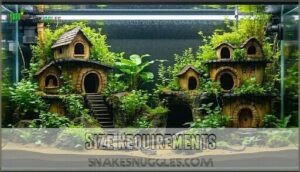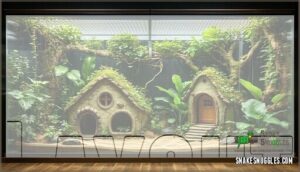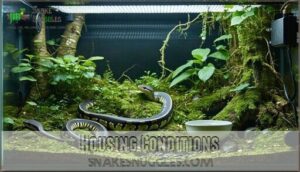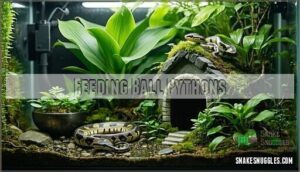This site is supported by our readers. We may earn a commission, at no cost to you, if you purchase through links.

This review examines the best hiding houses for ball pythons based on size specifications, material safety, humidity retention, and thermoregulation support to help you create an environment that mirrors their instinctive need for secure shelter.
Table Of Contents
- Key Takeaways
- Ball Python Basics
- Suitable Enclosure
- Housing Conditions
- Feeding Ball Pythons
- Handling Techniques
- Typical Health Issues
- Ensuring Proper Care
- Frequently Asked Questions (FAQs)
- Can ball pythons hide?
- How do you hide a ball python enclosure?
- Do ball pythons like roomier hides?
- How many hides do you need for a ball python enclosure?
- How do you keep a ball python?
- Can ball pythons live in a bare enclosure?
- What are the best types of hiding houses for ball pythons?
- How many hiding houses should I provide for my ball python?
- How often should I replace my ball pythons hide?
- Can ball pythons share hides with other snakes?
- Conclusion
Key Takeaways
- Ball pythons require at least two hiding houses positioned on both warm and cool sides of the enclosure to support natural thermoregulation while maintaining psychological security throughout the day.
- Inadequate hiding spots trigger chronic stress responses that suppress feeding behavior and compromise immune function, since these nocturnal snakes spend up to 23 hours daily concealed in tight, enclosed spaces.
- Proper hide selection must prioritize snug, body-conforming dimensions rather than spacious designs, as ball pythons instinctively seek tight refuges that mimic their native African burrows and termite mounds.
- Environmental conditions including 50-60% humidity levels, thermal gradients between 78-92°F, and appropriate substrate materials work together with quality hides to prevent respiratory infections, shedding complications, and stress-related health issues.
Ball Python Basics
Before you can create the perfect hiding house setup, you need to understand what drives your ball python’s behavior in the first place. These snakes evolved in specific conditions that shaped their needs for security, temperature control, and daily routines.
Let’s look at where they come from and how they naturally behave.
Native Habitat
Ball pythons call the sub-Saharan savannas and tropical regions of West and Central Africa home. In these wild environments, they seek shelter in abandoned pouched rat burrows, termite mounds, and rock crevices scattered across savannah landscapes. These native habitats shape their need for secure hiding houses in captivity.
African ecosystems provide the template: you’ll notice your ball python naturally gravitates toward tight, enclosed spaces that mimic those underground retreats. Understanding their native habitat and native climates—warm days, cooler nights, seasonal humidity shifts—helps you design a terrarium that accommodates their instinctive behaviors and reduces stress.
Ball pythons are popular pets due to their docile nature traits, which make them a great choice for many owners.
Behavior
Understanding their instincts helps you provide appropriate hiding houses. Ball pythons exhibit nocturnal patterns, remaining hidden during daylight hours and becoming active at night. Their snake behavior centers on thermoregulation—moving between warm and cool zones within their environment. Stress reduction depends on secure hiding spots, as these terrestrial snakes feel vulnerable in open spaces.
Consider these behavioral essentials for ball python care:
- They’re carnivorous, feeding primarily on rodents
- Snake temperament varies individually—some tolerate touching better than others
- Environmental enrichment through multiple hides supports natural animal behavior
- Social interaction should be limited; they’re solitary creatures requiring minimal touching initially.
Providing the right environment is vital for maintaining healthy ball python habits.
Suitable Enclosure
Your ball python needs the right enclosure to feel secure and thrive. The space you provide directly affects your snake’s stress levels, health, and overall behavior.
Let’s look at the specific size requirements and layout considerations that create an ideal environment.
Size Requirements
Choosing the right enclosure size directly affects your ball python’s stress levels and overall health. Hatchlings thrive in 20-gallon tanks, but adults need at least a 40-gallon space—ideally matching enclosures exceeding 36" x 18" x 12" to allow full stretching. Your snake’s length should guide hide dimensions and space allocation within the enclosure, maintaining proper enclosure ratio to support thermal gradients.
| Snake Stage | Minimum Enclosure Size | Hide Dimensions |
|---|---|---|
| Hatchling | 20 gallons | Small (1.5–2x body width) |
| Juvenile | 30–40 gallons | Medium (proportional to girth) |
| Adult | 40+ gallons (36"x18"x12") | Large (adjusted as they grow) |
Multiple hiding houses positioned on warm and cool ends help your ball python thermoregulate effectively while feeling secure throughout the snake habitat.
Layout
Once you’ve nailed down the right enclosure size, arranging the interior layout becomes your next priority for creating a stress-free environment. Position hiding houses on both warm and cool ends to establish thermal gradients essential for thermoregulation. Your reptile enclosure design should incorporate visual barriers like artificial plants or branches, creating spatial arrangement that mimics your snake’s terrestrial habitat while maintaining clear sight lines for monitoring.
- Place one hide on the basking side (88-92°F) and another on the cool side (78-80°F)
- Add climbing branches or cork bark to create vertical complexity without compromising floor space
- Use background elements and foliage to provide visual security while keeping hiding spots accessible
Housing Conditions
Once you’ve chosen the right enclosure size and layout, you need to dial in three critical environmental factors. Proper heating, humidity levels, and substrate choice work together to keep your ball python healthy and stress-free.
Let’s break down each requirement so you can create the ideal conditions.
Heating
Proper heating equipment establishes the thermal gradient ball pythons need for thermoregulation. You’ll want heating lamps—specifically halogen or infrared bulbs—positioned above the enclosure to create a basking spot between 90°F and 95°F, while the cool side remains at 78°F to 80°F. Radiant heat panels distribute warmth efficiently across thermal zoning areas without drying the air excessively.
Always pair your heat sources with a reliable thermostat and use both a digital thermometer and infrared temperature gun to monitor temperature control accurately, preventing dangerous hotspots or inadequate heating that suppresses digestion.
Humidity
Maintaining humidity levels between 50% and 60% is essential for healthy shedding and respiratory function in your ball python. You’ll monitor conditions using a hygrometer placed at mid-height in the terrarium, adjusting through strategic misting schedules or water bowls positioned on the warm side. Covering portions of mesh lids retains moisture effectively without creating stagnant air.
- Use digital hygrometers for accurate humidity monitoring in hiding houses
- Position large water bowls on the warm side to increase ambient humidity naturally
- Implement fogging systems for consistent moisture distribution in larger enclosures
- Target the warm zone during misting to prevent respiratory complications in your ball python
Substrate
Your substrate choice forms the foundation of your ball python’s microenvironment, directly influencing humidity retention, burrowing behavior, and long-term health outcomes. Aspen shavings, cypress mulch, and coconut husk rank among ideal bedding materials for reptile care, each offering distinct moisture levels and humidity control properties.
You’ll select substrate based on your terrarium’s ventilation characteristics, replacing contaminated sections weekly while performing complete habitat changes monthly. Avoid cedar or pine products, as aromatic oils compromise respiratory function in ball pythons.
Feeding Ball Pythons
When you get feeding right, your ball python stays active, maintains a healthy weight, and sheds like clockwork—but get it wrong, and you’ll face refusals, regurgitation, or aggression. Your snake’s diet should consist of appropriately-sized prekilled mice or rats as prey items—choose rodents that match the widest part of your snake’s body.
Meal frequency matters: juveniles eat weekly, while adults can go 10-14 days between feedings. Ball python feeding techniques include offering food at dusk when they’re naturally active, and maintaining proper nutrient balance means occasionally varying between mice and rats.
Monitor your snake’s body condition to adjust food sources and portions accordingly.
Handling Techniques
Think of managing your ball python like earning trust with a wary friend—rush the process, and you’ll face defensive strikes; move with patience, and you’ll build a relationship based on mutual respect. Start with brief sessions—just five minutes—and gradually extend the duration as your snake’s temperament allows. Support the entire body with gentle management techniques, avoiding sudden movements that trigger stress reduction needs. Wait 48 hours after feeding to prevent regurgitation and stress. Acclimation methods require consistency: manage every few days, never daily, allowing your ball python adequate recovery time between sessions.
- Watch for defensive posturing—your snake’s telling you it needs space
- Support their body weight completely—they’re not built for dangling
- Keep sessions short initially—you’re building confidence, not testing endurance
- Respect feeding schedules religiously—bite prevention starts with proper timing
Typical Health Issues
Captive ball pythons face preventable health crises when husbandry falls short—and recognizing early warning signs separates successful keepers from those facing emergency vet visits.
Respiratory issues top the list, with improper humidity below 50% triggering wheezing and mucus discharge. Skin diseases like scale rot emerge from excessive dampness, producing discolored scales and blisters that can progress to septicemia if ignored.
Parasite control demands vigilance, as mite infestations affect up to 38% of captive populations, causing dermatitis and stress. Infectious diseases like mouth rot—characterized by gingival swelling and tissue necrosis—strike immunocompromised individuals in poorly maintained enclosures.
Metabolic disorders from overfeeding every few days lead to obesity and fatty liver disease. Ball python shedding complications signal humidity problems requiring immediate correction for reptile health and wellbeing.
Ensuring Proper Care
Preventative husbandry separates thriving captive ball pythons from those cycling through veterinary clinics—consistent monitoring and environmental precision create the foundation for long-term health.
- Install thermostats for thermal management to maintain gradient accuracy between 88-92°F basking zones and 78-80°F cool areas.
- Monitor humidity control weekly, targeting 50-60% ambient levels to prevent respiratory infections and shedding complications.
- Inspect hiding houses and enclosure seams monthly for snake safety, eliminating escape routes and injury hazards.
- Add branches and cork bark for environmental enrichment that stimulates natural snake behavior patterns.
- Conduct health monitoring during feeding, noting appetite changes, scale condition, and movement abnormalities requiring veterinary assessment.
Frequently Asked Questions (FAQs)
Can ball pythons hide?
Ball pythons don’t just hide—they practically demand it. Studies show these pythons spend up to 23 hours daily in hiding spots.
Ball pythons spend up to 23 hours daily in hiding spots—they don’t just prefer secure spaces, they demand them
Your snake needs secure enclosures with multiple hiding houses positioned on warm and cool sides for proper thermoregulation and stress reduction.
How do you hide a ball python enclosure?
You don’t hide the ball python enclosure itself—you add visual barriers and secure hides inside it.
Place hiding houses on both warm and cool sides, using decorations to create thermal hiding spots and a sense of security for your snake.
Do ball pythons like roomier hides?
Unlike solitary creatures seeking refuge in caves, ball pythons don’t prefer spacious hides. Snake behavior research shows they actually favor snug, body-conforming hiding houses that increase python comfort levels and reduce snake stress.
Enclosure spatial needs should prioritize tight-fitting hide size preference over roominess.
How many hides do you need for a ball python enclosure?
You need at least two hides for your ball python enclosure—one on the warm side and one on the cool side.
This setup allows your snake to thermoregulate while maintaining security, as hiding spots on both ends of the temperature gradient support natural behavior and reduce stress.
How do you keep a ball python?
Think your snake’s just going to curl up anywhere? Not quite. Keeping a ball python means mastering Enclosure Design with proper Heating and Humidity Control, installing multiple Hiding Houses for Snake Safety, and creating a Python Environment with strategic Hiding Places that support natural thermoregulation.
Your Ball Python needs this Enclosure structure to thrive.
Can ball pythons live in a bare enclosure?
While technically possible, ball pythons shouldn’t live in bare enclosures. Environmental enrichment through hiding houses, visual barriers, and proper hide placement provides essential stress reduction and security features.
Your snake habitat needs these elements for psychological well-being, not just survival.
What are the best types of hiding houses for ball pythons?
Like a hermit crab seeking shelter, your ball python needs tight, dark hides on both warm and cool sides.
Secure enclosures with artificial or natural hides provide essential thermal regulation, burrowing capacity, and stress reduction through multiple reptile hideouts.
How many hiding houses should I provide for my ball python?
You’ll want to provide at least two hiding spots—one on the warm side and one on the cool side of your enclosure.
This dual placement facilitates proper thermoregulation while ensuring your ball python feels secure throughout its habitat, addressing fundamental snake behavior and thermal hide requirements.
How often should I replace my ball pythons hide?
Replace your ball python’s hide when hide material deteriorates, shows damage, or becomes difficult to clean. Solid hides last years with proper enclosure maintenance and regular cleaning schedules, but monitor for cracks or sharp edges that compromise snake safety in your snake enclosure setup.
Prioritizing reptile care means swapping hiding houses before they pose risks.
Can ball pythons share hides with other snakes?
Cohabitation risks in reptile care mirror a cautionary tale: forcing snakes into multi-snake arrangements ignores their solitary nature.
Ball pythons shouldn’t share hides with other snakes—doing so creates stress, spreads disease, and triggers aggressive snake behavior.
Each python requires dedicated hiding houses for proper reptile compatibility and psychological well-being.
Conclusion
Regarding securing your ball python’s well-being, the devil’s in the details. Selecting the best hiding houses for ball pythons isn’t just about aesthetics—it’s about replicating the snug, humid refuges they’d instinctively seek in African termite mounds.
Proper hides eliminate stress-induced feeding refusal and strengthen immune resilience. Prioritize appropriate sizing, non-toxic materials, and designs that support thermoregulation. Your python’s health depends on these foundational choices.
- https://www.state.gov/countries-areas/sierra-leone/
- https://community.morphmarket.com/t/what-size-hide/5237
- https://www.youtube.com/watch?v=zB20ArYcBWc
- https://reptifiles.com/ball-python-care-guide/ball-python-terrarium-size-lighting/
- https://talis-us.com/blogs/news/ball-python-hides-a-guide-to-providing-the-perfect-hideouts













